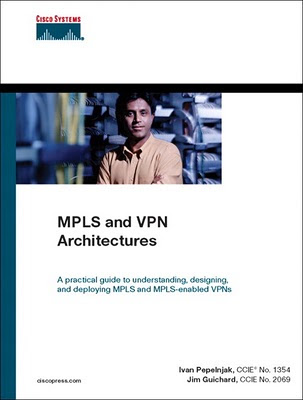
MPLS and VPN Architectures
By Jim CCIE #2069 Guichard, Ivan CCIE #1354 Pepelnjak
Publisher : Cisco Press
Pub Date : October 31, 2000
ISBN : 1-58705-002-1
Pages : 448
Slots : 2
Multiprotocol Label Switching (MPLS) provides the mechanisms to perform label switching, which is an innovative technique for high-performance packet forwarding. This book provides an in-depth study of MPLS technology, including MPLS theory and configuration, network design issues, and case studies. The MPLS/VPN architecture and all of its mechanisms are explained with configuration examples and suggested deployment guidelines. MPLS and VPNs provides the first in-depth discussion particular to Ciscos MPLS architecture. Multiprotocol Label Switching and Virtual Private Networks covers MPLS theory and configuration, network design issues, and case studies as well as one major MPLS application: MPLS-based VPNs. The MPLS/VPN architecture and all of its mechanisms are explained with configuration examples, suggested design and deployment guidelines, and extensive case studies.
Copyright
About the Authors
About the Technical Reviewers
Acknowledgments
Part I: MPLS Technology and Configuration
Chapter 1. Multiprotocol Label Switching (MPLS) Architecture Overview
Scalability and Flexibility of IP-based Forwarding
Multiprotocol Label Switching (MPLS) Introduction
Other MPLS Applications
Summary
Chapter 2. Frame-mode MPLS Operation
Frame-mode MPLS Data Plane Operation
Label Bindings and Propagation in Frame-mode MPLS
Penultimate Hop Popping
MPLS Interaction with the Border Gateway Protocol
Summary
Chapter 3. Cell-mode MPLS Operation
Control-plane Connectivity Across an LC-ATM Interface
Labeled Packet Forwarding Across an ATM-LSR Domain
Label Allocation and Distribution Across an ATM-LSR Domain
Summary
Chapter 4. Running Frame-mode MPLS Across Switched WAN Media
Frame-mode MPLS Operation Across Frame Relay
Frame-mode MPLS Operation Across ATM PVCs
Summary
Chapter 5. Advanced MPLS Topics
Controlling the Distribution of Label Mappings
MPLS Encapsulation Across Ethernet Links
MPLS Loop Detection and Prevention
Traceroute Across an MPLS-enabled Network
Route Summarization Within an MPLS-enabled Network
Summary
Chapter 6. MPLS Migration and Configuration Case Study
Migration of the Backbone to a Frame-mode MPLS Solution
Pre-migration Infrastructure Checks
Addressing the Internal BGP Structure
Migration of Internal Links to MPLS
Removal of Unnecessary BGP Peering Sessions
Migration of an ATM-based Backbone to Frame-mode MPLS
Summary
Part 2: MPLS-based Virtual Private Networks
Chapter 7. Virtual Private Network (VPN) Implementation Options
Virtual Private Network Evolution
Business Problem-based VPN Classification
Overlay and Peer-to-peer VPN Model
Typical VPN Network Topologies
Summary
Chapter 8. MPLS/VPN Architecture Overview
Case Study: Virtual Private Networks in SuperCom Service Provider Network
VPN Routing and Forwarding Tables
Overlapping Virtual Private Networks
Route Targets
Propagation of VPN Routing Information in the Provider Network
VPN Packet Forwarding
Summary
Chapter 9. MPLS/VPN Architecture Operation
Case Study: Basic MPLS/VPN Intranet Service
Configuration of VRFs
Route Distinguishers and VPN-IPv4 Address Prefixes
BGP Extended Community Attribute
Basic PE to CE Link Configuration
Association of Interfaces to VRFs
Multiprotocol BGP Usage and Deployment
Outbound Route Filtering (ORF) and Route Refresh Features
MPLS/VPN Data Plane—Packet Forwarding
Summary
Chapter 10. Provider Edge (PE) to Customer Edge (CE) Connectivity Options
VPN Customer Access into the MPLS/VPN Backbone
BGP-4 Between Service Provider and Customer Networks
Open Shortest Path First (OSPF) Between PE- and CE-routers
Separation of VPN Customer Routing Information
Propagation of OSPF Routes Across the MPLS/VPN Backbone
PE-to-CE Connectivity—OSPF with Site Area 0 Support
PE-to-CE Connectivity—OSPF Without Site Area 0 Support
VPN Customer Connectivity—MPLS/VPN Design Choices
Summary
Chapter 11. Advanced MPLS/VPN Topologies
Intranet and Extranet Integration
Central Services Topology
MPLS/VPN Hub-and-spoke Topology
Summary
Chapter 12. Advanced MPLS/VPN Topics
MPLS/VPN: Scaling the Solution
Routing Convergence Within an MPLS-enabled VPN Network
Advertisement of Routes Across the Backbone
Introduction of Route Reflector Hierarchy
BGP Confederations Deployment
PE-router Provisioning and Scaling
Additional Connectivity Requirements—Internet Access
Internet Connectivity Through Firewalls
Internet Access—Static Default Routing
Separate BGP Session Between PE- and CE-routers
Internet Connectivity Through Dynamic Default Routing
Additional Lookup in the Global Routing Table
Internet Connectivity Through a Different Service Provider
Summary
Chapter 13. Guidelines for the Deployment of MPLS/VPN
Introduction to MPLS/VPN Deployment
IGP to BGP Migration of Customer Routes
Multiprotocol BGP Deployment in an MPLS/VPN Backbone
MPLS/VPN Deployment on LAN Interfaces
Network Management of Customer Links
Use of Traceroute Across an MPLS/VPN Backbone
Summary
Chapter 14. Carrier's Carrier and Inter-provider VPN Solutions
Carrier's Carrier Solution Overview
Carrier's Carrier Architecture—Topologies
Hierarchical Virtual Private Networks
Inter-provider VPN Solutions
Summary
Chapter 15. IP Tunneling to MPLS/VPN Migration Case Study
Existing VPN Solution Deployment—IP Tunneling
Definition of VPNs and Routing Policies for PE-routers
Definition of VRFs Within the Backbone Network
VRF and Routing Polices for SampleNet VPN Sites
VRF and Routing Policies for SampleNet Internet Access
VRF and Routing Policies for Internet Access Customers
MPLS/VPN Migration—Staging and Execution
Configuration of MP-iBGP on BGP Route Reflectors
Configuration of MP-iBGP on TransitNet PE-routers
Migration of VPN Sites onto the MPLS/VPN Solution
Summary
Appendix A. Tag-switching and MPLS Command Reference
Index
Another Network Books
Download
No comments:
Post a Comment